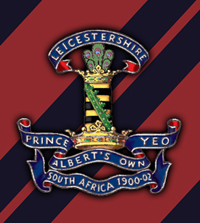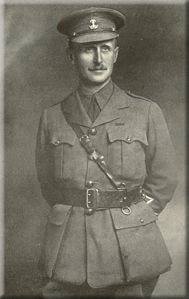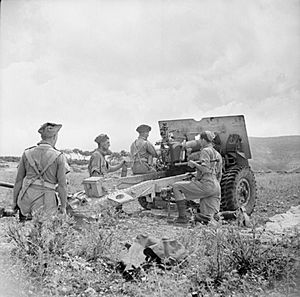Leicestershire Yeomanry facts for kids
Quick facts for kids The Leicestershire Yeomanry (Prince Albert's Own) |
|
|---|---|

Cap badge of The Leicestershire Yeomanry (P.A.O)
|
|
| Active | 1794–1802 1803–1957 |
| Country | |
| Branch | |
| Type | Yeomanry |
| Size | Regiment |
| HQ | Leicester |
| Nickname(s) | Albert Lads |
| Patron | Albert, Prince Consort |
| Motto(s) | "vultus en hostem" face the enemy |
| March | Regimental March by Henry Nicholson jnr (1825-1907) |
| Mascot(s) | Veld Baboon, "Adonse", from 1901 until his demise. Buried in Woodhouse Eves, Leicestershire. |
| Engagements | Second Boer War First World War
|
| Battle honours | See battle honours below |
The Leicestershire Yeomanry (Prince Albert's Own) was a special group of soldiers in the British Army. They were first formed in 1794 and then again in 1803. These soldiers were known as yeomanry, which meant they were originally volunteer cavalry (soldiers on horseback).
They fought as cavalry and mounted infantry (soldiers who rode horses but fought on foot) in the Second Boer War and the First World War. Later, in the Second World War, they became two field artillery regiments, using big guns. In 1957, they joined with another group, the Derbyshire Yeomanry, to form the Leicestershire and Derbyshire (Prince Albert's Own) Yeomanry. Today, their history is carried on by E (Leicestershire and Derbyshire Yeomanry) Squadron of the Royal Yeomanry.
Contents
- History of the Regiment
- Battle Honours: Recognising Bravery
- Uniforms of the Leicestershire Yeomanry
- See also
- Further Resources
History of the Regiment
How the Regiment Began
In 1794, people in Britain were worried about a possible invasion from France. The government asked different areas to create volunteer groups of soldiers. In Leicestershire, a meeting was held in April 1794 to start a yeomanry regiment.
Sir William Skeffington, a retired Major, became their first leader. By June, they had enough men. The regiment showed off its new flags on July 4th. This first group was disbanded in 1802 after a peace agreement was signed.
The 1800s: Keeping the Peace
The regiment was started again in September 1803. It was called the Leicestershire Yeomanry Cavalry. This showed it was seen as the same group, just reformed. Lieutenant-Colonel George Keck became the new leader.
From 1825, the regiment also welcomed soldiers from Rutland. The Leicestershire Yeomanry often helped keep order. For example, in 1831, they helped the regular army control riots in Derby. These riots happened after a new law about voting was rejected.
In 1844, the regiment was renamed in honor of Prince Albert, the husband of Queen Victoria.
Fighting in the Second Boer War
Yeomanry soldiers were not usually sent to fight overseas. But in December 1899, the British Army needed more soldiers for the Second Boer War in South Africa. So, a special order was made to allow volunteer forces to go.
The Leicestershire Yeomanry sent two companies (groups of about 115 men) to join the fighting in 1900. In 1901, they changed their style of fighting to become "mounted infantry." This meant they rode horses to get around but fought on foot.
Later, in 1908, they became part of the Territorial Force. They went back to being cavalry, like hussars (a type of light cavalry). Their main base was in Leicester.
The First World War: A Global Conflict
When the First World War started in 1914, many soldiers in the Territorial Force volunteered to fight overseas. Because of this, the yeomanry units were split into different groups:
- 1st Line units went to fight abroad.
- 2nd Line units stayed home for defense.
- 3rd Line units trained new soldiers as replacements.
1st Leicestershire Yeomanry: On the Front Lines
The 1st Leicestershire Yeomanry went to France in November 1914. They were one of only a few yeomanry regiments to join a regular cavalry division. They fought in major battles like the First Battle of Ypres in 1914 and the Second Battle of Ypres in 1915.
At the Second Battle of Ypres, they earned special honors for their bravery at the Battle of St Julien and the Battle of Frezenberg. At Frezenberg, a small group from the regiment bravely held their position against many enemy soldiers.
The Battle of Frezenberg
On May 12, 1915, at Frezenberg, the Leicestershire Yeomanry fought as infantry (on foot) in the trenches. They faced heavy shelling and attacks from German soldiers. Despite many losses, they showed great courage.
Their leader, Lt. Colonel The Hon. Percy Cecil Evans-Freke, was killed while bravely directing the defense. Even with heavy casualties, the remaining soldiers held their ground until help arrived. This battle showed their amazing determination.
Later Years of the War
After the heavy fighting at Second Ypres, the regiment didn't see much action in 1916. In 1917, they fought in the Battle of Arras and the Battle of the Scarpe.
In 1918, they were split up to help other cavalry regiments. Different squadrons (smaller groups of soldiers) joined other units. They fought in important battles like the Battle of Amiens and the Pursuit to Mons, helping to push back the enemy.
2nd Leicestershire Yeomanry: Home Defense
The 2nd Line regiment was formed in 1914. Their job was to defend Britain. They moved around different parts of England, training and preparing. At one point, they were even converted to cyclists, riding bicycles instead of horses! Later, they were remounted (given horses again) and then became cyclists once more. They stayed in Canterbury until the war ended.
3rd Leicestershire Yeomanry: Training New Soldiers
The 3rd Line regiment was formed in 1915. Their main role was to train new soldiers. These new recruits would then be sent to join the 1st and 2nd Line regiments as replacements when needed. They were based at Aldershot.
Between the World Wars
After the First World War, military leaders realized that cavalry (soldiers on horseback) were not as important anymore. New technologies like tanks and armored cars were changing warfare.
Many yeomanry regiments were changed into other types of units, like armored car companies or artillery units. However, the Leicestershire Yeomanry was one of the few regiments that kept its role as horsed cavalry for a while longer.
The Second World War: Artillery Role
Even though the Second World War was about to start, the regiment still trained with horses. But in 1939, it was decided that they would change roles. They became two separate Royal Artillery regiments, meaning they would operate large guns.
- 153rd (Leicestershire Yeomanry) Field Regiment, Royal Artillery was formed in February 1940.
- 154th (Leicestershire Yeomanry) Field Regiment, Royal Artillery was formed in April 1940.
The 153rd Regiment fought across northern France. The 154th Regiment served in North Africa and then in the Italian campaign. They were part of the forces occupying Austria after the war.
After the Wars: New Roles
After the Second World War, the regiment became a yeomanry regiment again. They joined the Royal Armoured Corps and were equipped with Comet Tanks. In 1952, they changed again to become an Anti-Tank Regiment, still using armored vehicles.
Finally, in 1957, the Leicestershire Yeomanry joined with the Derbyshire Yeomanry to form the Leicestershire and Derbyshire Yeomanry.
Battle Honours: Recognising Bravery
The Leicestershire Yeomanry earned many special "battle honours" for their bravery and service in different wars. These honours are like special awards that show where the regiment fought with distinction. Some of these honours are proudly displayed on their regimental flags.
| Second Boer War | South Africa 1900–02 | |
| First World War | Ypres 1914 '15, St. Julien, Frezenberg, Arras 1917, Scarpe 1917, Amiens, Hindenburg Line, Canal du Nord, Pursuit to Mons, France and Flanders 1914–18 | |
| Second World War | The Royal Artillery has a special motto, Ubique (meaning "everywhere"), instead of individual battle honours, because they were involved in almost every battle.
Honorary Distinction: A special badge of the Royal Regiment of Artillery with the years "1942, '44–45" and three scrolls: "North-West Europe", "North Africa" and "Italy" |
Uniforms of the Leicestershire Yeomanry
Before 1914, officers of the regiment wore a fancy hussar-style uniform. This included a tall hat called a busby with a white and red feather. They also wore a short, dark blue jacket with red parts and silver decorations, and tight dark blue trousers with red stripes. Other soldiers wore a dark blue peaked cap and white decorations.
This special uniform is still worn today by a small group of soldiers from the modern B Squadron (LBY) during important ceremonies. For everyday service, from 1903 onwards, all soldiers wore khaki uniforms, which were more practical for fighting.
See also
- Imperial Yeomanry
- List of Yeomanry Regiments 1908
- Yeomanry
- Yeomanry order of precedence
- British yeomanry during the First World War
- Second line yeomanry regiments of the British Army
- List of British Army Yeomanry Regiments converted to Royal Artillery
Further Resources
If you want to learn more about the Leicestershire Yeomanry, here are some books and websites:
- Codrington, Col. G.R. – An outline of the history of the Leicestershire (Prince Albert's Own) Yeomanry. Arden Press, London, 1928.
- Brassey, Bernard & Winslow, P.D. – 153rd Leicestershire Yeomanry Field Regiment R.A., T.A. 1939-1945. W.Pickering & Sons, Hinckley, 1947
- Bouskell-Wade, Lt. Col. G.E. – "There is an Honour Likewise..." The Story of 154 (Leicestershire Yeomanry) Field Regiment, RA. E. Backus, Leicester, 1948.
- Steppler, Glenn A. – Britons, to arms! – The Story of the British Volunteer Soldier and the Volunteer Tradition in Leicestershire and Rutland. Budding Books, Stroud, 1997
- www.paoyeomanry.co.uk – official website for The Leicestershire (PAO) Yeomanry and The Leicestershire & Derbyshire (PAO) Yeomanry.






